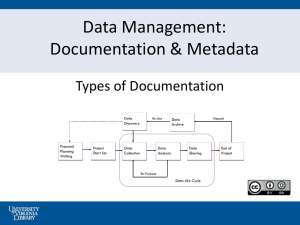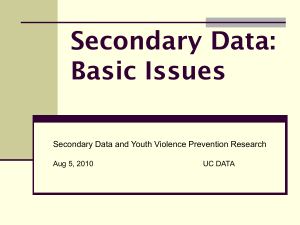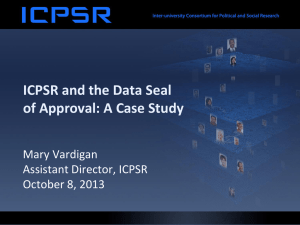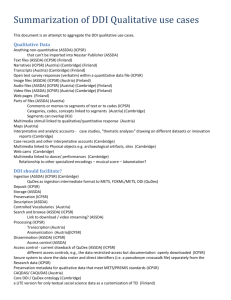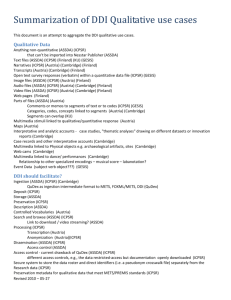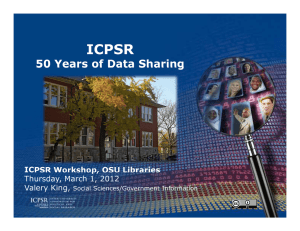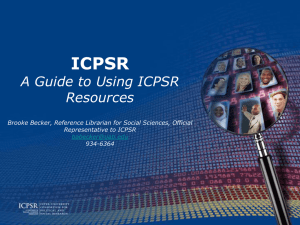- California State University, Los Angeles
advertisement
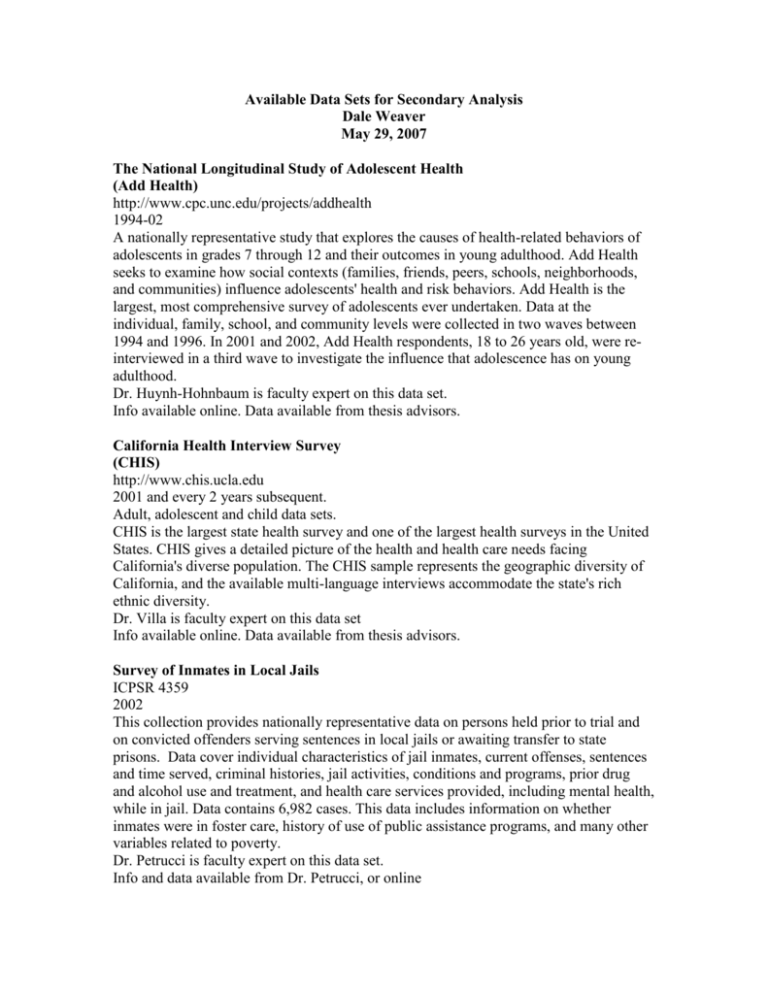
Available Data Sets for Secondary Analysis Dale Weaver May 29, 2007 The National Longitudinal Study of Adolescent Health (Add Health) http://www.cpc.unc.edu/projects/addhealth 1994-02 A nationally representative study that explores the causes of health-related behaviors of adolescents in grades 7 through 12 and their outcomes in young adulthood. Add Health seeks to examine how social contexts (families, friends, peers, schools, neighborhoods, and communities) influence adolescents' health and risk behaviors. Add Health is the largest, most comprehensive survey of adolescents ever undertaken. Data at the individual, family, school, and community levels were collected in two waves between 1994 and 1996. In 2001 and 2002, Add Health respondents, 18 to 26 years old, were reinterviewed in a third wave to investigate the influence that adolescence has on young adulthood. Dr. Huynh-Hohnbaum is faculty expert on this data set. Info available online. Data available from thesis advisors. California Health Interview Survey (CHIS) http://www.chis.ucla.edu 2001 and every 2 years subsequent. Adult, adolescent and child data sets. CHIS is the largest state health survey and one of the largest health surveys in the United States. CHIS gives a detailed picture of the health and health care needs facing California's diverse population. The CHIS sample represents the geographic diversity of California, and the available multi-language interviews accommodate the state's rich ethnic diversity. Dr. Villa is faculty expert on this data set Info available online. Data available from thesis advisors. Survey of Inmates in Local Jails ICPSR 4359 2002 This collection provides nationally representative data on persons held prior to trial and on convicted offenders serving sentences in local jails or awaiting transfer to state prisons. Data cover individual characteristics of jail inmates, current offenses, sentences and time served, criminal histories, jail activities, conditions and programs, prior drug and alcohol use and treatment, and health care services provided, including mental health, while in jail. Data contains 6,982 cases. This data includes information on whether inmates were in foster care, history of use of public assistance programs, and many other variables related to poverty. Dr. Petrucci is faculty expert on this data set. Info and data available from Dr. Petrucci, or online Changing Lives of Older Couples (CLOC) http://www.cloc.isr.umich.edu Haven’t used this one, but it looks good. CLOC is a multi-wave prospective study of spousal bereavement, designed and carried out by a research team including Camille Wortman, Ron Kessler, Jim House and Jim Lepkowski. Data were gathered from a two-stage area probability sample of 1,532 elderly married men and women from the Detroit Metropolitan Area. Initial face-to-face interviews were conducted between June 1987 and April 1988. Follow-up interviews of bereaved spouses and controls were conducted at 6, 12 and 48 months after the loss, and continued until 1993. While primarily a study of spousal bereavement, the dataset also includes a host of other psychosocial and biomedical variables. The combined dataset includes 1532 cases and over 3000 variables that cover every aspect of social, psychological, and physical functioning of older adults DATA BELONGING TO FACULTY Asian American Children and Families in Foster Care Systems: Factors Leading to Different types of Out-of-Home Placement and Experiences of Immigrant Asian Families in the U.S. Public Child Welfare System 2002 Data derived from the case files of 763 clients of the Asian Pacific Unit of the LAC DCFS. Data and codebook available from Dr. Rhee. Child Maltreatment, Drugs and Crime among Male Offenders (MALTREATMENT) 1999 400 young adult male incarcerated offenders. Good on child abuse, criminal behavior, PTSD Data and codebook available from Dr. Crimmins or Dr. Weaver. The Retention of California’s Public Child Welfare Workers 2004 Statewide survey of newly hired child welfare workers. Numerous job related variables, such as intention to leave, job satisfaction, quality of supervision. The report is available at: http://www.calstatela.edu/faculty/dweaver/weaver.chang.retention.doc Data available from Dr. Weaver Retention of Inter-University Consortium (IUC) and California Social Work Education Center (CalSWEC) MSW Interns at the Los Angeles County Department of Children and Family Services 2006 LA only, longitudinal survey of Title IV-E, with emphasis on retention. Additional agency and psychosocial variables. Report and data available from Dr. Weaver SOCIAL SCIENCE RESEARCH & INSTRUCTIONAL CENTER http://www.ssric.org The CSU system has a Web site devoted to accessing and analyzing available data. This is a very good entry point to numerous data archives. There is an online tutorial in SPSS, assistance in converting ASCII files to SPSS files, and instruction in the use of SDA. SDA (Survey Documentation and Analysis) is an online data analysis program. Using this enables the student to analyze existing data without having SPSS. Not all data sets use SDA, but an increasing number do. I have tried it, and it seems cumbersome, but it may be worth it if you are not familiar with SPSS and want to do data analysis yourself. INTER-UNIVERSITY CONSORTIUM FOR POLITICAL AND SOCIAL RESEARCH ICPSR http://www.icpsr.umich.edu/ The place to go to find data sets, including most of those listed below. Choose a topic, search by key words, identify relevant data sets. Look at the documentation, especially the codebook to see if the data sets include the specific variables you are looking for. Not all of the data sets are easily downloadable. Some have raw data and SPSS syntax files to define the data, rather than downloadable SPSS files. This can be tricky. Just because the codebook lists a particular variable doesn’t mean that the N and the distribution of that variable in the actual data is analyzable. Before finalizing your thesis proposal, work with your advisor to directly access the data and look at the frequencies of your major variables. ICPSR has data archives particular to aging: National Archive of Computerized Data on Aging (NACDA): http://www/icpsr.com/NACDA/ And to criminal justice: National Archive of Criminal Justice Data (NAJCD): http://www.icpsr.com/NACJD/ And substance and mental health: Substance Abuse and Mental Health Data Archive (SAMHDA): http://www.icpsr.com/SAMHDA/ The data sets listed below have been used by thesis students, are somewhat familiar to Dr. Weaver and are directly available from him. Sometimes I list theses completed from these data sets. National Survey of Adolescents in the United States ICPSR 2833 1995 The goal of this study was to test specific hypotheses illustrating the relationships among serious victimization experiences, the mental health effects of victimization, substance abuse/use, and delinquent behavior in adolescents. The study assessed family and nonfamilial types of violence. Variables include stressful live events, history of victimization, personal and family substance use and mental health, and demographic information. Data collected from adolescents and their parents. Thesis: Maalouf Impact of the Court Process on Sexually Abused Children in North Carolina ICPSR 9985 1983-1986 Examines the psychological impact of judicial processes on child sexual abuse victims. An old data set, with relatively few subjects, but has the merit of collecting data directly from child abuse victims. Thesis: Nora Sanchez Preventing Depression in Couples Facing Job Loss ICPSR 3567 1996-1998 6534 couples – unemployed job-seekers and their spouses Thesis: Vardumyan American Perceptions of Aging in the 21st Century ICPSR 3325 2000 Records changes in views about aging among older people as well as younger adults. Major issues include the myth of generational warfare, aging experiences in the past 25 years, retirement, health, and anticipations of a long life. Demographic variables include race, age, gender, religion, education and income. Thesis: Underwood, Ditko National Survey of Self-Care and Aging: Baseline ICPSR 6718 1991 3500 elderly. Self-care behavior, activities of daily living, social support, demographics National Survey of Problems Facing Elderly Americans Living Alone ICPSR 9379 1986 National sample of 2000 over 65, plus 500 over 75 Demographics, well-being, health, etc. I haven’t figured out how to import the data yet. National Survey of Hispanic Elderly People ICPSR 9289 1988 Similar to above, but only Hispanic. About 2000 cases. Religion, Aging, and Health Survey ICPSR 3255 2001, 2004 About 1000 Black and White elderly. Religion, depression, well-being SOCIOMETRICS DATA ARCHIVES http://www.socio.com/dataarchives.htm Another good Web site for data bases. Very user friendly. Categories of data sets: HIV/AIDS, adolescent pregnancy, aging, families, child well-being and poverty, and alternative medicine. California Perinatal Substance Exposure Study (Perinatal) 1992 Large number of subjects - 29,500 California women, but few variables. Extensive prenatal drug exposure info, with a number of comparison variables. 1991 National Survey of Men (AIDS/STD) National sample of 3321 males 20-39 Health and sexual behavior. Attitudes, including self-esteem and locus of control.
